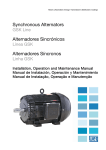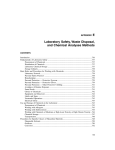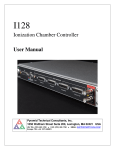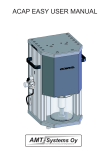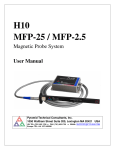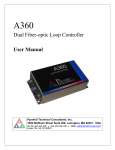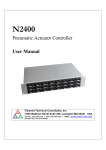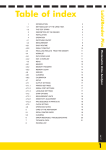Download BPM16-38 - Pyramid Technical Consultants
Transcript
BPM16-38 Beam Position Monitor User Manual Pyramid Technical Consultants, Inc. 1050 Waltham Street Suite 200, Lexington, MA 02421 USA US: TEL: (781) 402-1700 ♦ FAX: (781) 402-1750 ♦ EMAIL: [email protected] Europe: TEL: +44 1273 492001 PSI System Controls and Diagnostics 1 Contents 1 CONTENTS ........................................................................................................................................................2 2 FIGURES ............................................................................................................................................................4 3 SAFETY INFORMATION ...............................................................................................................................5 4 MODELS ............................................................................................................................................................7 5 SCOPE OF SUPPLY .........................................................................................................................................8 6 OPTIONAL ITEMS...........................................................................................................................................9 6.1 6.2 7 READOUT .........................................................................................................................................................9 SIGNAL CABLES AND CABLE ACCESSORIES .......................................................................................................9 INTENDED USE AND KEY FEATURES .....................................................................................................10 7.1 7.2 INTENDED USE ...............................................................................................................................................10 KEY FEATURES ..............................................................................................................................................10 8 SPECIFICATION ............................................................................................................................................11 9 INSTALLATION .............................................................................................................................................15 9.1 PREPARATION AND HANDLING........................................................................................................................15 9.2 MOUNTING .....................................................................................................................................................15 9.2.1 Coordinate conventions .......................................................................................................................16 9.2.2 Beam direction .....................................................................................................................................17 9.2.3 Rotation orientation .............................................................................................................................18 9.3 CABLING AND SERVICES .................................................................................................................................19 9.3.1 Connections .........................................................................................................................................19 9.3.2 Cable and pipe arrangement ...............................................................................................................21 9.3.3 Alignment and connection to vacuum beamline ..................................................................................22 9.4 VACUUM FORCE .............................................................................................................................................23 10 AN OVERVIEW OF THE BPM16-38 ...........................................................................................................24 10.1 IONIZATION CHAMBERS .............................................................................................................................24 10.1.1 Signal formation..............................................................................................................................24 10.1.2 Gain calibration ..............................................................................................................................25 10.1.3 Recombination ................................................................................................................................27 10.2 POSITION READOUT ...................................................................................................................................28 10.2.1 Beam centroid .................................................................................................................................28 10.2.2 Beam width......................................................................................................................................31 10.3 BPM16-38 MECHANICAL ASSEMBLY........................................................................................................31 10.3.1 Ionization chamber electrodes ........................................................................................................31 10.3.2 Gas pocket.......................................................................................................................................32 10.3.3 Vacuum housing ..............................................................................................................................32 10.3.4 Actuator system ...............................................................................................................................34 11 CONNECTORS................................................................................................................................................35 11.1 ELECTRICAL ..............................................................................................................................................35 BPM16-38 User Manual BPM16-38_UM_131023 Page 2 of 48 PSI System Controls and Diagnostics 11.1.1 Vertical sense signal output ............................................................................................................35 11.1.2 Horizontal sense signal output ........................................................................................................36 11.1.3 High voltage input...........................................................................................................................37 11.1.4 Actuator control ..............................................................................................................................37 11.1.5 Redundant limit switch outputs .......................................................................................................37 11.2 PNEUMATIC PRESSURE ..............................................................................................................................38 11.3 FILL GAS ....................................................................................................................................................38 12 MAINTENANCE .............................................................................................................................................39 12.1 PNEUMATIC CYLINDER LUBRICATION ........................................................................................................39 12.1.1 Procedure........................................................................................................................................39 12.2 VACUUM BELLOWS REPLACEMENT ............................................................................................................40 12.2.1 Procedure........................................................................................................................................41 12.3 MICROSWITCH ADJUSTMENT .....................................................................................................................41 12.3.1 Procedure........................................................................................................................................41 12.4 SPARE PARTS .............................................................................................................................................41 13 FAULT-FINDING............................................................................................................................................43 14 RETURNS PROCEDURE...............................................................................................................................45 15 SUPPORT .........................................................................................................................................................46 16 DISPOSAL ........................................................................................................................................................47 17 REVISION HISTORY .....................................................................................................................................48 BPM16-38 User Manual BPM16-38_UM_131023 Page 3 of 48 PSI System Controls and Diagnostics 2 Figures Figure 1. BPM layout; sensor out of beam position (bellows extended). Dimensions mm. ..............................13 Figure 2. BPM layout continued; sensor out of beam position (bellows extended)). Dimensions mm. ............14 Figure 3. BPM mounting face. .................................................................................................................................15 Figure 4. Ion optics standard coordinate convention (Transport). ......................................................................16 Figure 5. BPM16-38 internal coordinate system....................................................................................................17 Figure 6. BPM strip numbering relative to conventional beamline coordinates for beam entering via signal connector face (left) and via pneumatic connection face (right) ..................................................................18 Figure 7. Schematic installation. .............................................................................................................................20 Figure 8. Fixed and moving cable connections. ......................................................................................................21 Figure 9. High flex cable connecting the actuator control connector to the solenoid valve. ..............................22 Figure 10. Ionization chamber signal formation. ...................................................................................................24 Figure 11. Approximate gain curve for the BPM16-38, protons in air at SATP. ...............................................26 Figure 12. Measured chamber gains and corresponding centroid and width determinations, as a function of beam current of 228 MeV protons. .................................................................................................................27 Figure 13. Test result extract showing residual offsets of BPM sensor................................................................28 Figure 14. Beam position in BPM sensor coordinates (blue) ................................................................................29 Figure 15. Displacement of BPM body coordinates(red) from BPM sensor coordinates (blue) ........................30 Figure 16. Change to beamline coordinates (green) ..............................................................................................30 Figure 17. Ionization chamber electrode assembly. ...............................................................................................31 Figure 18. Electrode assembly mounted on spindle. ..............................................................................................32 Figure 19. Gas pocket and foil windows. ................................................................................................................32 Figure 20. Vacuum housing with sensor extended (in beam position), engaged on alignment pins ..................33 Figure 21. Vacuum housing with sensor retracted (out of beam position) ..........................................................33 Figure 22. Complete BPM assembly with sensor extended (left) and retracted (right)......................................34 Figure 23. Cylinder lubrication – step A. ...............................................................................................................40 Figure 24. Cylinder lubrication – step B.................................................................................................................40 Figure 25. Microswitch adjustment – step A. Upper switch (right) and lower switch (left) .............................41 BPM16-38 User Manual BPM16-38_UM_131023 Page 4 of 48 PSI System Controls and Diagnostics 3 Safety Information This unit is designed for compliance with harmonized electrical safety standard EN610101:2000. It must be used in accordance with its specifications and operating instructions. Operators of the unit are expected to be qualified personnel who are aware of electrical safety issues. The customer’s Responsible Body, as defined in the standard, must ensure that operators are provided with the appropriate equipment and training. The unit is designed to make measurements in Measurement Category I as defined in the standard. CAUTION. Entrapment hazard. The BPM is moved using pneumatic pressure during normal operation. There is a risk of fingers being trapped in pinch points. Never place body parts near the device when pneumatic pressure is present. CAUTION. High voltage. High voltage must be provided to this device for correct operation. The high voltage is not exposed in the correctly assembled unit. A voltage of up to + or – 1000 V DC at 1.0 mA maximum is supplied to the BPM via the SHV connector. The hazardous live voltages delivered to the BPM are not accessible under the definitions of EN61010 but may nevertheless give a noticeable shock if misuse were to lead you to come into contact with them. The user must therefore exercise appropriate caution when servicing the device and when connecting cables. Power should be turned off before making any connections. The body of the BPM should be grounded via its connection to the customer’s beamline and/or mounting. If this is not the case, or if local regulations require, a safety ground must be securely connected to the ground lug on the case. CAUTION. Radiation. After use in a high-energy particle accelerator beamline, the BPM may become activated. Do not BPM16-38 User Manual BPM16-38_UM_131023 Page 5 of 48 PSI System Controls and Diagnostics work on the device, or move the device from a controlled area until it has been surveyed and declared safe by a qualified radiation supervisor. Only Service Personnel, as defined in EN61010-1, should attempt to work on the disassembled unit, and then only under specific instruction from Pyramid Technical Consultants, Inc. Some of the following symbols may be displayed on the unit, and have the indicated meanings. Direct current Earth (ground) terminal Protective conductor terminal Frame or chassis terminal Equipotentiality Supply ON Supply OFF CAUTION – RISK OF ELECTRIC SHOCK CAUTION – RISK OF DANGER – REFER TO MANUAL CAUTION – ENTRAPMENT HAZARD BPM16-38 User Manual BPM16-38_UM_131023 Page 6 of 48 PSI System Controls and Diagnostics 4 Models BPM16-38 Beam position monitor with sixteen sensing strips and 38mm sensing length in each axis. -CF With fixed tapped CF (Conflat™) 2 ¾ inch / DN40 flanges -KF With NW KF40 flanges -FLO With fittings for flow gas operation Example: BPM16-38-CF-FLO BPM16-38 User Manual BPM with CF flanges and in/out flow gas fittings. BPM16-38_UM_131023 Page 7 of 48 PSI System Controls and Diagnostics 5 Scope of Supply BPM16-38 model as specified in your order. Four pin Weidmuller mating connector for redundant limit switch connection. USB memory stick containing: BPM16-38 User manual Test data Optional items as specified in your order. BPM16-38 User Manual BPM16-38_UM_131023 Page 8 of 48 PSI System Controls and Diagnostics 6 Optional Items 6.1 Readout I3200-XP10 32-channel electrometer with +1 kV bias supply and actuator control. I3200-XP20 32-channel electrometer with +2 kV bias supply and actuator control. 6.2 Signal cables and cable accessories CAB-D25M-5-D25F Cable, multiway low-noise, DSub 25 pin male to DSub 25 way female, 5 m. CAB-D25M-10-D25F Cable, multiway low-noise, DSub 25 pin male to DSub 25 way female, 10 m. CAB-SHV-5-SHV Cable, coaxial HV, SHV to SHV, 5 m. CAB-SHV-10-SHV Cable, coaxial HV, SHV to SHV, 10 m. CAB-D9M-5-D9F Cable, multiway, DSub 9 pin male to DSub 9 way female, 5 m. CAB-D9M-10-D9F Cable, multiway, DSub 9 pin male to DSub 9 way female, 10 m. BPM16-38 User Manual BPM16-38_UM_131023 Page 9 of 48 PSI System Controls and Diagnostics 7 Intended Use and Key Features 7.1 Intended Use The BPM16-38 is intended to provide position and shape readout of high-energy ion beams, nominally proton beams in the energy range 30 to 350 MeV. It will form a part of a complete beam diagnostics suite in a particle accelerator system. The BPM performs a semi-destructive measurement of the beam. Although the beam passes through the device, the amount of scattering it receives is generally too great for the beam downstream to be used for other purposes. The BPM16-38 therefore includes a pneumatic actuator system to move the sensor element completely out of the beam path once the measurement has been made. The BPM16-38 is intended to be incorporated into a high vacuum beamline, and is leak tested in the final stage of manufacture and test. It is not fully-UHV compatible because it includes elastomer seals, and thus cannot be baked to high temperatures. Moderate heating of the metal body to 70C maximum is acceptable to accelerate outgassing. The BPM may also be operated in atmosphere. The operating environment should be clean and free of vibration. Users should be familiar with vacuum technology and low current measurement. 7.2 Key Features • Low insertion length and choice of vacuum connectors. • Small gap ionization chamber with 16 by 16 sensing strips. • 38 mm by 38 mm sensitive area. • Operation with atmospheric air or flow-through gas. • Bias voltage up to 1 kV. • High-vacuum compatible. • Robust low-maintenance IC housing with bonded thin stainless steel windows. • Integrated pneumatic actuation with dual limit-switch end-point sensing. • Precision guides for in-beam location. • 100000 cycle nominal bellows life. • Compatible with the I3200 electrometer. BPM16-38 User Manual BPM16-38_UM_131023 Page 10 of 48 PSI System Controls and Diagnostics 8 Specification Beam compatibility Species Protons, deuterons, helium ions, carbon ions Energy range 30 MeV/nucleon to 500 500 MeV / nucleon Beam current density 10 pA cm-2 to 20 nA cm-2 Sensor Type Parallel plate dual ionization chamber with multistrip cathodes HV bias range 500 V to 2000 V Sensitive area 38 mm by 38 mm Vacuum pipe internal diameter will define sensitive area. Sensitive volume 6mm anode – cathode spacing, each axis. Readout strip geometry 16 strips, equal width 2.38 mm on 2.534 mm pitch. Readout strip orientation Horizontal sensing strips = sensing orthogonal to the axis along the centre of the vacuum bellows. Vertical sensing strips = sensing in the axis along the centre of the vacuum bellows. Vacuum Vacuum regime High vacuum (1 e-8 mbar or greater). Bakeout Maximum bakeout 70C (with screening of the electrical components and forced gas cooling of the sensor volume) Vacuum materials Stainless steel, aluminium alloy, Viton O ring seals Bellows Edge-welded stainless steel, rated lifetime > 100,000 cycles Beam path windows 50 µm stainless steel foil, diffusion bonded. Beampath materials Layers BPM16-38 User Manual 1: 50 µm stainless steel foil entrance window 2: 10.8 mm fill gas 3: 152 µm FR4 fiberglass epoxy with 17.3 µm gold-flashed copper cathode strips 4: 6 mm fill gas (active volume) 5: 152 µm FR4 fiberglass epoxy with 17.3 µm gold-flashed copper anode planes each side 6: 6 mm fill gas (active volume) 7: 152 µm FR4 fiberglass epoxy with 17.3 µm gold-flashed copper cathode strips BPM16-38_UM_131023 Page 11 of 48 PSI System Controls and Diagnostics 8: 10.8 mm fill gas 9: 50 µm stainless steel foil exit window Actuator Type Pneumatic, dual acting cylinder with DC solenoid control. Travel 58 mm Solenoid valve Coil 24 VDC, 50 mA. DC voltage applied holds the sensor in the beam path. Pneumatic pressure 75 psi minimum, 110 psi maximum, clean dry air (CDA) or nitrogen. Maximum cylinder life is obtained with lubricated CDA. Limit sensing Dual redundant microswitch sensing of fully in and fully out positions. Position reproducibility Sensor positioning in beam reproduces to +/- 0.1 mm in actuator motion direction, +/-0.25 mm in transverse dimension, referenced to BPM reference mounting surface. Position accuracy Sensor positioning in beam within +/- 0.25 mm of BPM body mechanical centre, in both axes, relative to BPM referenced to BPM reference mounting surface. Mechanical Insertion length 152.4 mm (6”) flange face to flange face with CF flanges. Orientation Operable in any orientation. Vertical orientation (actuator above beampipe) recommended for best position reproducibility. Weight 12 kg (26.4 lb) Operating environment Clean and dust-free 5 to 35 C (15 to 25 C recommended), < 70% humidity, non-condensing Vibration < 0.1g all axes, 0.1 to 1000 Hz. Shipping and storage environment Vacuum flanges should be sealed off and gas ports should be plugged. -10 to 50 C < 80% humidity, non-condensing Vibration < 1g all axes, 0.1 to 1000 Hz. Dimensions See figures 1and 2 for dimensions BPM16-38 User Manual BPM16-38_UM_131023 Page 12 of 48 PSI System Controls and Diagnostics Figure 1. BPM layout; sensor out of beam position (bellows extended). Dimensions mm. BPM16-38 User Manual BPM16-38_UM_131023 Page 13 of 48 PSI System Controls and Diagnostics Figure 2. BPM layout continued; sensor out of beam position (bellows extended)). Dimensions mm. BPM16-38 User Manual BPM16-38_UM_131023 Page 14 of 48 PSI System Controls and Diagnostics 9 Installation 9.1 Preparation and handling The BPM16-38 is shipped as a vacuum-tested clean assembly. Do not remove protective covers until the unit can be mounted in its operating position in a clean, dry area. Use gloves if you might touch any vacuum surfaces. Take care to protect knife edges on CF flanges, or sealing surfaces on KF flanges. Similarly, any preparation or service work must be carried out in a clean, dry environment. CAUTION. Entrapment hazard. Once pneumatic pressure has been connected, there is a risk of unexpected movement of the actuator. Exercise due care. 9.2 Mounting The BPM16-38 should be mounted via the reference face on its base, as this is where the sensor position is referenced. A pattern of four M6 threaded holes is provided on a precision machined surface. The weight of the device should be taken via this mounting, not via the beamline flanges. The mounting must be aligned accurately with the beamline ion optical elements, rigid and not subject to vibration. Depending upon your application, you may require that the mount provides position adjustment in the two transverse axes, so that the BPM can be adjusted relative optical elements in the beamline, to remove physically any offsets. Figure 3. BPM mounting face. BPM16-38 User Manual BPM16-38_UM_131023 Page 15 of 48 PSI System Controls and Diagnostics 9.2.1 Coordinate conventions In the conventional beamline optics convention, z is always directed along the beam forward direction (thus tangent to beam trajectory when in a dipole field), the horizontal (X axis) is defined as orthogonal to z and outwards along the radius of curvature of local dipole magnets, and vertical (Y axis) being the orthogonal direction to Z and X (and thus the non-dispersion direction of dipole magnets. However your facility may adopt a different convention – check carefully to ensure you know how the BPM orientation you use relates to your coordinate system. Y X Z Bending by dipole magnet Figure 4. Ion optics standard coordinate convention (Transport). The BPM16-38 has a natural internal XY coordinate system arising from the way the cathode strips are numbered, and this in turn is based on the assumption that an I3200 electrometer is used to read out the device using pin to pin cabling, with channels 1-16 used for the vertical sensing and 17-32 for the horizontal. Figure 5 shows this internal coordinate system. BPM16-38 User Manual BPM16-38_UM_131023 Page 16 of 48 PSI System Controls and Diagnostics Y Y X X Figure 5. BPM16-38 internal coordinate system 9.2.2 Beam direction The BPM can be inserted into the beamline facing in either direction. The choice may be constrained by physical interferences with other beamline components. The sensor chamber is symmetric, the only difference being which sensing axis the beam sees first as it passes through, and whether the positive X direction for conventional beam optics coordinates has increasing or decreasing strip numbering. Referring to figure 5, you can see that the internal coordinate system has the same sense as the conventional beamline optics system if the BPM is mounted with the pneumatic solenoid upstream. If you mount in the other direction, with the signal connectors upstream, you must remember to make the necessary inversion when converting from BPM coordinates to conventional beamline coordinates. As an example, figure 6 shows how the BPM strips are arranged relative to the conventional beamline coordinate system if the beam enters the BPM faces shown in figure 5. BPM16-38 User Manual BPM16-38_UM_131023 Page 17 of 48 PSI System Controls and Diagnostics H sense Ch32 Ch17 Ch16 Ch16 V sense Y Y V sense Ch1 Ch1 Ch17 X Beamline coordinates Z Ch32 X H sense Z Beamline coordinates Figure 6. BPM strip numbering relative to conventional beamline coordinates for beam entering via signal connector face (left) and via pneumatic connection face (right) With high energy beams, the order in which the beam passes the vertical and horizontal halves of the sensor will make no difference to the reading. At and below the low end of the specification proton energy range, you may start to see the beam width apparently greater than it actually is in the downstream chamber, due to scattering in the entrance window and upstream chamber. This will have negligible effect on the centroid computation. If you use low energy X-rays to test the BPM on the bench, then you will see less integrated signal from the downstream half of the sensor, due to absorption. 9.2.3 Rotation orientation The BPM will operate in any rotation orientation (rotation about the beam axis), to facilitate use on beamline gantry systems. The position reproducibility and accuracy are guaranteed for mounting with the actuator vertical in the absolute sense, either above or below the beamline. Note that the terms “horizontal-sensing” and “vertical sensing” lose their absolute meaning if the beamline or the BPM is rotated. Usually we refer to horizontal and vertical relative to the nearest dipole magnets (figure 4). Beamline optics that use dipole, quadrupole and sextupole elements in standard relative orientations preserve the independence of the beam envelope trajectory in X and Y. This means we can look at the progression of X profiles along a sequence of BPMs independently of the Y profiles. If a BPM needs to be mounted at some arbitrary rotation angle to the local beamline coordinate system, then readout becomes complicated, and the data handling and display must manage this coordinate transformation. Rotation of the BPM by 90 degrees exchanges X and Y. Rotation by 180 degrees swaps the directions of X and Y. However a sensor mounted at an arbitrary angle mixes X and Y in the data, which complicates interpretation, and is therefore not recommended. BPM16-38 User Manual BPM16-38_UM_131023 Page 18 of 48 PSI System Controls and Diagnostics 9.3 Cabling and services 9.3.1 Connections The following cable connections are required: Function Connector on the BPM16-38 Location on the BPM16-38 Vertical axis readout Dsub 25-way male Moving upper body Horizontal axis readout Dsub 25-way male Moving upper body Bias voltage input SHV receptacle Moving upper body Actuator control and limit switch readback Dsub 9-way male Static lower body Redundant limit switch readback (optional) Weidmuller 3.81mm 4-way terminal header male Static lower body The following service connections are required: Function Connector on the BPM16-38 Location on the BPM16-38 Pneumatic pressure in ¼” tubing Moving upper body Fill gas in (optional) Threaded hole for 1/8” NPT fitting Moving upper body Fill gas out (optional) Threaded hole for 1/8” NPT fitting Moving upper body Figure 7 shows a schematic installation using the Pyramid I3200 electrometer for readout. The I3200 is well-suited as it provides HV bias and actuator control as well as ionization chamber readout. BPM16-38 User Manual BPM16-38_UM_131023 Page 19 of 48 PSI System Controls and Diagnostics Pneumatic pressure Flow gas in/out (optional) I3200 V sense HV bias H sense Actuator control and readback Redundant limit switch output (optional) Figure 7. Schematic installation. The location of the I3200 must reconcile the conflicting requirements to keep the signal cables short for best noise performance, but keep the electronics out of the radiation field. A maximum cable length of 10 m is recommended. Longer cables will still function, but signal to noise performance will degrade, and the capacitive load may introduce systematic calibration offsets. Refer to the I3200 user manual for further details on cable lengths. Low-noise signal cables must be used to minimize noise due to cable movement and vibration. These are available to special order from Pyramid Technical Consultants, Inc. The actuator control link to the I3200 provides the switched 24 VDC for solenoid actuation, and reads back the “in” and “out” limit switches. A separate redundant set of limit switches allows the same information to be sent to an independent system, for example for safety interlocking. The BPM16-38 operates the same whether or not this optional connection is made. The BPM16-38 can be supplied with pipe fittings to suit 1/8” OD pipe for flow gas feed and return as an option (-FLO option). Flow gas is not necessary for the sensor to function, but it may be preferred in some installations where the atmosphere is humid, or where large atmospheric pressure excursions are common. BPM16-38 User Manual BPM16-38_UM_131023 Page 20 of 48 PSI System Controls and Diagnostics 9.3.2 Cable and pipe arrangement Give careful attention to the routing of cables and pipe that connect to the BPM. All the connections that make to the moving upper body should be routed so that the movement of the cable or pipe when the actuator moves is allowed for, without any strain being placed on the connections. A strain-relief bracket is provided for the signal and HV cables, and the pneumatic feed pipe may also be routed via this point. Do not tie the moving (signal and high voltage) and non-moving (actuator control) cables together within 1 metre (3’) of the BPM. There should be no tendency for the cable to the nonmoving part to move during actuation. Failure to observe this precaution may result in failure of the actuator connection due to flexing. Figure 8. Fixed and moving cable connections. BPM16-38 User Manual BPM16-38_UM_131023 Page 21 of 48 PSI System Controls and Diagnostics The flexible cable connection between the actuator DSub connector on the static part of the BPM, and the solenoid valve must also be allowed to flex freely without risk of interference with other cables or services. Pay particular attention to this if the BPM is rotated out of the vertical, or would be rotated by a beamline gantry rotation. Figure 9. High flex cable connecting the actuator control connector to the solenoid valve. 9.3.3 Alignment and connection to vacuum beamline Each BPM is factory-tested for sensor positioning accuracy relative to the reference mounting surface, and the test data includes values for the residual offset in horizontal (X) and vertical (Y) axes. The errors will be less than 0.25 mm in X and Y. When you install the BPM you may wish to compensate these small residual errors if an adjustable mount permits it, or simply include the offsets in the software calibration of the sensor response. The BPM must be surveyed and aligned relative to the ion optical components of the beamline (the magnets), not to the vacuum pipe. Generally the BPM16-38 must therefore be connected to the beam pipe via flexible sections on either side. The exception would be in beamlines where vacuum chambers are designed to be precision aligned to magnet pole pieces. See section 10.2.1 for more information on how to read out beam position with appropriate corrections for residual offsets. BPM16-38 User Manual BPM16-38_UM_131023 Page 22 of 48 PSI System Controls and Diagnostics 9.4 Vacuum force When the BPM16-38 is under vacuum, atmospheric pressure will try to contract the bellows and thus move the sensor into the beam path. This force is overcome by the pneumatic pressure in normal operation. The default position for the actuator (solenoid un-energized) is for the sensor to be clear of the beam, so you should be aware that this condition will not be met if pneumatic pressure is lost. BPM16-38 User Manual BPM16-38_UM_131023 Page 23 of 48 PSI System Controls and Diagnostics 10 An Overview of the BPM16-38 10.1 Ionization chambers 10.1.1 Signal formation High energy ions pass through matter with relatively small lateral scattering and energy loss, but nevertheless leave a trail of ionization behind. In the ionization chamber the free charge that is created is separated by the applied bias voltage, with the positive air ions moving to the cathodes, which are grounded at the virtual earths of the readout preamplifiers, and the electrons (or negative ions formed by electron capture) moving to the anode. The resulting small current is measured by the readout electronics. The current from an individual ion is too small to measure, but for beam currents of a few 10’s of pA or more, the aggregate current can be measured by sensitive electrometer electronics. Cathode Anode Cathode +-+-+ - + +- +- +- +-+- + - + +- + ++-- + - +- +- +-- + - +- +- Beam ion + HV Pre-amp Pre-amp Figure 10. Ionization chamber signal formation. The ionization chamber uses a parallel plate geometry to provide uniform gain over its active area. At higher applied bias voltages and with field intensifying geometry such as thin wires or points, the chamber would start operate in the proportional regime, where the signal is increased greatly by electron avalanching. This regime is generally avoided in high energy ion beamlines, because it is less stable, and the chamber is more prone to degradation from beam exposure. Although the readout strips on the cathodes are separated by small gaps, all the charge arriving at the cathodes is routed by the electric field onto the strips. Therefore you can safely assume that the effective strip width is the same as the strip pitch, and the conversion to physical units is given by multiplying a result in strips by the strip pitch. BPM16-38 User Manual BPM16-38_UM_131023 Page 24 of 48 PSI System Controls and Diagnostics 10.1.2 Gain calibration The energy to produce an ion-electron pair is almost constant for a given target species, and very small compared to the energy carried by the ion, hence the minimal effect on the beam. Air Nitrogen gas Oxygen gas Argon gas Helium gas 34 eV 36.4 eV 32.2 eV 26.3 eV 42.7 eV The amount of ionization per ion in the gas filling of the BPM ionization chamber depends upon the gas composition (essentially constant if atmospheric air is used), the distance travelled through the gas, the pressure of the gas, and to a small extent, the energy of the ion. If the factors mentioned above are fixed by control or by calibration, for example against a Faraday cup collector, then the effective gain of the ionization chamber, (= chamber signal / ion beam current) is known and the BPM can be used to give a reasonable indication of beam current. The approximate gain curve for the BPM16-38 with 6 mm electrode spacing, as a function of beam energy for protons in air at standard ambient temperature and pressure, is as shown in figure 10 below. A value of 75 was measured for the BPM16-38 for 228 MeV protons, with atmospheric air filling. CAUTION If the BPM16-38 is used for critical dosimetry applications, then you must use accurate gain values referenced to traceable standards, and regularly validated. If the BPM is only being used to measure the position and shape of the beam, then we don’t need to know the gain accurately, only that it is consistent across the chamber. BPM16-38 User Manual BPM16-38_UM_131023 Page 25 of 48 PSI System Controls and Diagnostics 300.0 250.0 Gain 200.0 150.0 100.0 50.0 0.0 50 100 150 200 250 300 Proton energy (MeV) Gap 6 mm 150.0 Gain 100.0 50.0 0.0 100 150 200 250 Proton energy (MeV) Gap 6 mm Figure 11. Approximate gain curve for the BPM16-38, protons in air at SATP. BPM16-38 User Manual BPM16-38_UM_131023 Page 26 of 48 PSI System Controls and Diagnostics Since the gain at any beam energy is a function of the gas density in the electrode gaps, it has to be corrected for variation in pressure and temperature, relative to the gain at some reference pressure and temperature where it is known. For example, if you know the gain at standard atmospheric temperature and pressure (SATP; Temperature_SATP = 298.15 K, Pressure_SATP = 100000 Pa), then the actual gain for another air pressure and temperature is given by Gain_ACTUAL = Gain_SATP *1/[ (Pressure_SATP / Pressure_ACTUAL ) * ( Temperature_ACTUAL / Temperature_SATP)] Temperatures must be in Kelvin, pressures can be in any convenient absolute unit. 10.1.3 Recombination The upper beam current measurement limit of the ionization chamber is set by recombination of the ions and electrons before they can be collected on the electrodes, which reduces the measured current. Recombination is a function of the local beam current density, the electric field strength, the gas composition and pressure. It is mitigated in the BPM16-38 by the use of a small anodecathode gap and a relatively high bias voltage. At low current densities, corresponding to ion beam currents up to around 10 nA, recombination is neglible and can be safely ignored. Even at higher currents, the effect on the measurement of the beam centroid and width is comparatively little affected. The BPM16-38 has been tested with 1 kV bias at beam currents up to 35 nA and shown negligible difference in the computed beam parameters. 7.00 5.00 Gain 4.00 3.00 70 2.00 Centroid / width (mm) 6.00 90 1.00 50 0.00 0 5 10 15 20 25 30 35 40 Beam current (nA) V gain H gain Centroid Width Figure 12. Measured chamber gains and corresponding centroid and width determinations, as a function of beam current of 228 MeV protons. BPM16-38 User Manual BPM16-38_UM_131023 Page 27 of 48 PSI System Controls and Diagnostics 10.2 Position readout The strip pitch of the BPM16-38, S = 2.534 mm, is relatively small compared to the beam width for the intended application, so that you will see signal on three strips at least. You can then use peak fitting or centre of mass calculation to determine the position of the peak to much less than one strip width, typically 10% of the strip width or less for normal beam currents and noise levels. A centre of mass calculation (CoG) is simple to calculate and makes no assumptions about the shape of the peak. However it is unreliable if the whole peak is not included, or if excess background noise or offset is included. A fit to a Gaussian is often the best solution. Pyramid real time controller products include fast algorithms for peak fitting and centroid finding. 10.2.1 Beam centroid The sensor strip geometry is controlled to high accuracy by the use of precision PCB manufacturing techniques. The centre of the pattern is between the eighth and ninth strips in each axis, with the strips numbered from 1 to 16 vertical, and 17 to 32 horizontal. Thus in a perfect system with no offsets, a perfectly centred beam would give a centroid reading of 24.500 strips in X and 8.5 in Y, which you would typically translate as a physical position of (0.000, 0.000) mm. If you determine a peak position, (PX, PY) expressed in strips, then the position in physical units in the BPM coordinate system (figure 5) is given by XS = (PX - 24.5) * S YS = (PY - 8.5) * S To translate to the beamline coordinate system we must allow for any rotations of the BPM relative to the beamline coordinate system due to the way it is mounted, and also for any residual offsets between the BPM sensor coordinate system and the beamline coordinate system. The residual offsets between the sensor and the body of the BPM are determined during final factory test, and are given in the test results. The offsets are given in the BPM coordinate system, in microns. Figure 13. Test result extract showing residual offsets of BPM sensor BPM16-38 User Manual BPM16-38_UM_131023 Page 28 of 48 PSI System Controls and Diagnostics Offsets of the BPM body relative to its ideal position in the beamline coordinate system will be determined during beamline survey. The following example, with grossly exaggerated offsets, shows how a measured X position in sensor coordinates is translated to the beamline coordinate system. We’ll take the more complicated case where the beamline X axis direction is opposite to the BPM X axis direction. Firstly, the raw centroid, XS, is found in the sensor coordinate system from the cathode strip signals, using a suitable centroid calculation. XS 17 32 Figure 14. Beam position in BPM sensor coordinates (blue) Next we recognize that the beam position relative to BPM body must be adjusted by the residual offset, ∆X0, measured in the factory. This measurement tells us where the body is relative to the sensor coordinate system. It is simplest to express this as the displacement of the sensor centre relative to the body, which is the negation of the value dX given in the test data, and in the sensor coordinate system. BPM16-38 User Manual BPM16-38_UM_131023 Page 29 of 48 PSI System Controls and Diagnostics ΔX0 17 32 Figure 15. Displacement of BPM body coordinates(red) from BPM sensor coordinates (blue) Finally we change to beamline coordinates. In this example this involves a change in the X axis direction, and a further measured residual offset, ∆X1, of the BPM body relative to the beamline, stated in the beamline coordinate system. ΔX1 ΔX0 17 32 Figure 16. Change to beamline coordinates (green) Thus the beam position in beamline coordinates is XB = λ(XS - ∆X0) + ∆X1 BPM16-38 User Manual BPM16-38_UM_131023 Page 30 of 48 PSI System Controls and Diagnostics where λ=1 if the sensor X axis is in the same direction as the beamline axis, and λ=-1 if it is in the opposed direction. An alternative approach better suited to a final installation, is to assign absolute positions to the strips in beamline coordinates, with all scaling and offsets included, and store this in a software data file linked to the particular BPM. The beam centroid calculation will them return directly a value in beamline coordinates. 10.2.2 Beam width Conversion of computed beam width to physical units is simply a matter of multiplying the width computed in strips to mm by multiplying by the strip pitch. 10.3 BPM16-38 Mechanical Assembly 10.3.1 Ionization chamber electrodes The heart of the BPM16-38 is the dual ionization chamber electrode stack. This is manufactured from special thin FR4 PCB material using standard PCB manufacturing techniques, which give extremely high geometric accuracy. Cross hairs on the back sides of the cathodes are centred on the electrode strip patterns, allowing external optical alignment. Figure 17. Ionization chamber electrode assembly. The anode PCB in the middle is copper clad on both sides, to form the anode for both halves of the chamber. Note that the strips on the cathodes are orthogonal to the sensing direction (vertical strips sense in the horizontal axis, for example). The electrode assembly is mounted on a hollow bore spindle that provides a route for the signal ribbon cables, HV bias coaxial cable and flow gas tube. BPM16-38 User Manual BPM16-38_UM_131023 Page 31 of 48 PSI System Controls and Diagnostics Figure 18. Electrode assembly mounted on spindle. 10.3.2 Gas pocket A gas and vacuum-tight cap fits to the end of the spindle (shown transparent in the following figure). Figure 19. Gas pocket and foil windows. Thin stainless steel foil windows allow the passage of the beam. They are diffusion-bonded to the housing, and should require no maintenance for the life of the BPM. It is possible to assemble the BPM with the gas pocket removed if required for alignment checking. The crosshairs on the backs of the cathodes are then visible. 10.3.3 Vacuum housing The gas pocket moves within the vacuum housing. At the end of travel, in the extended position, it engages on precision alignment pins to bring it into close alignment to the vacuum housing for BPM16-38 User Manual BPM16-38_UM_131023 Page 32 of 48 PSI System Controls and Diagnostics the X axis. The housing includes the precision mounting face. Stub tubes with alternative vacuum flanges can be mounted to suit the beamline standard. Figure 20. Vacuum housing with sensor extended (in beam position), engaged on alignment pins Figure 21. Vacuum housing with sensor retracted (out of beam position) BPM16-38 User Manual BPM16-38_UM_131023 Page 33 of 48 PSI System Controls and Diagnostics 10.3.4 Actuator system The vacuum housing is stationary, and the pneumatic actuator bears on it to move the sensor, gas pocket, spindle and the whole upper part of the assembly relative to it. An edge-welded bellows maintains vacuum while allowing the motion. Sensor connections pass up through the bellows and are terminated on bulkhead connectors. Dual microswitches make when the movement is within 4 mm of the end of travel. In the extended position, the travel limit is set by an adjustable hard stop, pre-set in manufacture, which defines the position accuracy in the Y axis. Figure 22. Complete BPM assembly with sensor extended (left) and retracted (right) BPM16-38 User Manual BPM16-38_UM_131023 Page 34 of 48 PSI System Controls and Diagnostics 11 Connectors 11.1 Electrical 11.1.1 Vertical sense signal output DSub 25 pin male. (External view on connector / solder side of mating plug) View of cathode strips looking from the signal connectors side. Cathode strips are on the front side of the cathode from this view. 16 15 14 13 12 11 10 9 8 7 6 5 4 3 2 1 1 2 3 4 5 6 7 8 9 10 11 12 13 Strip 2 Strip 3 Strip 4 Strip 5 Strip 6 Strip 7 Strip 8 Strip 9 Strip 10 Strip 11 Strip 12 Strip 13 Strip 14 14 15 16 17 18 19 20 21 22 23 24 25 Strip 1 n/c AGnd AGnd AGnd AGnd AGnd AGnd AGnd AGnd Strip 16 Strip 15 The connector is compatible with a pin to pin connection to an I3200 electrometer. Strip 1 is connected to channel 1 and so on up to strip 16 being connected to channel 16. BPM16-38 User Manual BPM16-38_UM_131023 Page 35 of 48 PSI System Controls and Diagnostics 11.1.2 Horizontal sense signal output DSub 25 pin male. (External view on connector / solder side of mating plug) View of cathode strips looking from the signal connectors side. Cathode strips are on the back side of the cathode from this view. 17 18 19 20 21 22 23 24 25 26 27 28 29 30 31 32 1 2 3 4 5 6 7 8 9 10 11 12 13 Strip 18 Strip 19 Strip 20 Strip 21 Strip 22 Strip 23 Strip 24 Strip 25 Strip 26 Strip 27 Strip 28 Strip 29 Strip 30 14 15 16 17 18 19 20 21 22 23 24 25 Strip 17 n/c AGnd AGnd AGnd AGnd AGnd AGnd AGnd AGnd Strip 32 Strip 31 The connector is compatible with a pin to pin connection to an I3200 electrometer. Strip 17 is connected to channel 17 and so on up to strip 32 being connected to channel 32. BPM16-38 User Manual BPM16-38_UM_131023 Page 36 of 48 PSI System Controls and Diagnostics 11.1.3 High voltage input SHV receptacle. To mate with standard SHV connector. Core: high voltage (2 kV max) Outer screen: shield (at chassis GND) 11.1.4 Actuator control Dsub 9 pin male. (External view on connector / solder side of mating plug) 1 Solenoid power (switched +24 VDC in) 6 Limit switch common 2 Solenoid return 7 Limit switch in 3 n/c 8 n/c 4 n/c 9 n/c 5 Limit switch out The connector is compatible with a pin to pin connection to the actuator control port on an I3200 electrometer. When the actuator is retracted, pin 5 is connected to pin 6. When the actuator is extended (in beam), pin 7 is connected to pin 6. 11.1.5 Redundant limit switch outputs Weidmuller 4 position 3.81 mm. Two potential-free contact pairs. “Out” contacts close when the switch senses the actuator is retracted (sensor out of beam), “In” contacts close when the switch senses the actuator is extended (sensor in beam). BPM16-38 User Manual BPM16-38_UM_131023 Page 37 of 48 PSI System Controls and Diagnostics 11.2 Pneumatic pressure Push-fit connection (SMC “One-touch” / McMaster Carr “push to connect”) for ¼” od plastic hose. 11.3 Fill gas Gas flow fittings are optional for customers who do not wish to operate the ionization chamber sensor in atmospheric air. 1/8” NPT threaded holes are provided in the upper body of the BPM for this purpose. The BPM16-38 can be ordered with the –FLO option which includes suitable fittings. The feed tube which passes down to the ionization chamber volume should be connected on the inside to the fitting for the incoming gas. The outgoing gas is simply expelled from the internal gas space of the BPM. The flow should be regulated, and typical rates are very low, <= 1 sccm. BPM16-38 User Manual BPM16-38_UM_131023 Page 38 of 48 PSI System Controls and Diagnostics 12 Maintenance The BPM16-38 is designed for minimal maintenance. There are two recommended preventative maintenance procedures, and one adjustment that may be necessary. CAUTION. Radiation. Do not work in the beamline area, or on the BPM, until a survey has been completed by a qualified radiation supervisor and the radiation is known to be at acceptable levels. CAUTION. Entrapment hazard. Do not work on the BPM until pneumatic pressure has been removed. 12.1 Pneumatic cylinder lubrication The cylinder should be lubricated with several drops of 10-weight engine oil every 500 hours of continuous operation. At 4 seconds typical per in and out movement, this corresponds to 450,000 cycles. The procedure can be carried out with the BPM on the beamline. 12.1.1 Procedure 1) Remove pneumatic pressure and make safe using the working procedures for your site. 2) Disconnect the gas feed to the top of the cylinder. BPM16-38 User Manual BPM16-38_UM_131023 Page 39 of 48 PSI System Controls and Diagnostics Figure 23. Cylinder lubrication – step A. 3) Unscrew the pressure reducing valve, taking care not to change the setting. 4) Drop lubricant into the cylinder bore. Figure 24. Cylinder lubrication – step B. 5) Reconnect the valve and pipe. Restore the pneumatic pressure and cycle the actuator several times to confirm correct operation. 12.2 Vacuum bellows replacement The vacuum bellows are rated for 100,000 cycles of operation. You may wish to replace them as a preventative measure at or around this stage. The BPM must be removed from the beamline and partially disassembled to replace the bellows. BPM16-38 User Manual BPM16-38_UM_131023 Page 40 of 48 PSI System Controls and Diagnostics 12.2.1 Procedure The assembly requires precision alignment following replacement of the vacuum bellows. We therefore recommend that the BPM is returned to Pyramid for bellows replacement and refurbishment. Full details of the procedure will be supplied on request to users who have received appropriate training. 12.3 Microswitch adjustment The microswitches should close when the actuator moves to within 2-4 mm of the hard end stop. You may need to adjust this if the switches are replaced, or if the setup is lost due to other work of accident. The BPM should not be under vacuum, so that the motion can be made manually. 12.3.1 Procedure 1) Move the BPM by hand to the fully retracted and fully extended positions. Ensure the microswitch actuation block contacts the switch rollers as shown. Figure 25. Microswitch adjustment – step A. Upper switch (right) and lower switch (left) 2) Half-tighten the retaining screws, and move between the two positions to confirm that both switches at each end close between 4 and 2 mm of the hard stop. Adjust the positions as need to achieve this. Use a DVM to measure switch continuity. 3) When correct and consistent, tighten the screws and do a final check. 12.4 Spare parts Item Vacuum bellows Pneumatic cylinder Solenoid valve assy Solenoid drive cable Microswitch Signal and bias PCB Actuator control PCB BPM16-38 User Manual Part number Pyramid 11204461 Pyramid 165692 SY5120-5LN-N7T-F2 SS-01GL2D 9000-11112 9000-11128 BPM16-38_UM_131023 Supplier Metal Flex Nevada Inc. Bimba SMC Pyramid Technical Cons. Omron Pyramid Technical Cons. Pyramid Technical Cons. Page 41 of 48 PSI System Controls and Diagnostics V sense cathode H sense cathode Anode CF flange assy Compressed gas tube ¼” Ribbon cable assy Anode cable assy Gas pocket assy BPM16-38 User Manual 9000-11078 9000-11076 9000-11080 17219330 5181K232 HF18U-12-ND 11204490 BPM16-38_UM_131023 Pyramid Technical Cons. Pyramid Technical Cons. Pyramid Technical Cons. Pyramid Technical Cons. McMaster-Carr Digikey. Pyramid Technical Cons. Pyramid Technical Cons. Page 42 of 48 PSI System Controls and Diagnostics 13 Fault-finding The BPM16-38 is designed to give you trouble-free service. We expect that a simple replacement policy will be followed for any units that fail on a beamline, and that failed units will be returned to Pyramid for refurbishment. However the following fault-finding is provided to help decide whether a BPM should be exchanged, and to guide repairs for customers who do not have a service arrangement. Symptom Possible Cause Actuator does not move Insufficient pneumatic Check pressure pressure Mechanism is stuck. Remove pneumatic pressure and attempt to move manually. Control cable Check cable disconnected Cables or pipes are Visual inspection. snagging Solenoid failure Limit switches not reading as expected. Error in position readout BPM16-38 User Manual Flow restrictors set incorrectly. Switches out of position. Confirmation 24 V across the solenoid? Solenoid magnetic field detectable? Check incoming gas pressure. Visual inspection. Solution Use correct pressure (75 to 110 psi). Maintain mechanism as necessary. Ensure cables are connected and secure. Ensure all incoming cables and services allow free actuator movement in all operating orientations. Replace solenoid as necessary. Adjust restrictors as necessary. Adjust and secure microswitches so that they close within 2 to 4mm of the end of travel. Replace switch as necessary, re-set position. Switches faulty Disconnect actuator and check switch function with a DVM. Mechanism not reaching end of travel and engaging with alignment pins. BPM is installed in an Visual inspection – has actuator reached the hard stops? Maintain mechanism as necessary. Visual inspection; Ensure calibration BPM16-38_UM_131023 Page 43 of 48 PSI System Controls and Diagnostics orientation that invalidates calibration values. X and Y axis cables swapped. check calibration values being used. values are correct. Check cable Ensure cables are connected and secure. Small or no signal HV bias not reaching the BPM. Check HV supply. Check cable integrity. Correct as necessary. If no external cause of missing HV, remove BPM and check internal connection. Unstable signal HV arcing due to high humidity. Reduce HV and see if instability reduces. Improve air conditioning. Check signal again when no vibration or movement. Improve air conditioning. Consider using flow gas. Use low-noise cables. Do not use data from immediately after the actuator is moved. Leak check Aggravated by actuator movement. Leak check. Leak check (feed helium into gas pocket). Repair as necessary Repair as necessary. Triboelectric noise. Bad vacuum Leak on seal Leak on bellows Leak on diffusion bond BPM16-38 User Manual BPM16-38_UM_131023 Replace gas pocket as necessary. Page 44 of 48 PSI System Controls and Diagnostics 14 Returns procedure Damaged or faulty units cannot be returned unless a Returns Material Authorization (RMA) number has been issued by Pyramid Technical Consultants, Inc. If you need to return a unit, contact Pyramid Technical Consultants at [email protected], stating - model - serial number - nature of fault CAUTION. Radiation. The unit cannot be shipped until it is certified to be below legal limits for radiation, and that it is clear of any chemical contamination. An RMA will be issued, including details of which service center to return the unit to. We recommend that you retain the original shipping carton to use for returns. BPM16-38 User Manual BPM16-38_UM_131023 Page 45 of 48 PSI System Controls and Diagnostics 15 Support Manual and other documentation updates are available for download from the Pyramid Technical Consultants website at www.ptcusa.com. Technical support is available by email from [email protected]. Please provide the model number and serial number of your unit, plus relevant details of your application. BPM16-38 User Manual BPM16-38_UM_131023 Page 46 of 48 PSI System Controls and Diagnostics 16 Disposal We hope that the BPM16-38 gives you long and reliable service. The BPM16-38 is manufactured to be compliance with the European Union RoHS Directive 2002/95/EC, and as such should not present any health hazard, once any activation has decayed. CAUTION. Radiation. The BPM must not be released from a radiation controlled area until it has been surveyed and declared safe by a qualified Radiation Supervisor. When your BPM16-38 has reached the end of its working life, you must dispose of it in accordance with local regulations in force. If you are disposing of the product in the European Union, this includes compliance with the Waste Electrical and Electronic Equipment Directive (WEEE) 2002/96/EC. Please contact Pyramid Technical Consultants, Inc. for instructions when you wish to dispose of the device. BPM16-38 User Manual BPM16-38_UM_131023 Page 47 of 48 PSI System Controls and Diagnostics 17 Revision History The release date of a Pyramid Technical Consultants, Inc. user manual can be determined from the document file name, where it is encoded yymmdd. For example, B10_UM_080105 would be a B10 manual released on 5 January 2008. Version Changes BPM16-38_UM_120420 First general release BPM16-38_UM_130521 Added information on gain curves and temperature and pressure correction. BPM16-38_UM131023 Added information and picture for cable strain relief Corrected gain temperature and pressure correction equation. BPM16-38 User Manual BPM16-38_UM_131023 Page 48 of 48





















































